
IT'S TOO early in the genealogy of the small SUV to apply Darwinian ‘theory of evolution’ logic to know exactly what to expect next.
Natural selection has played a huge part in the success (and failure) of Golf-class hatchbacks, perhaps to the detriment of any major product innovation in more recent times, but that homogeneity has yet to hit the almost wilfully diverse small-SUV category. So should we be grateful or guffawing at the results?
The daringly drawn Hyundai Kona may provoke some of the latter. Its out-there styling is far removed from the Euro-sleek appearance of its i30 platform cousin, but maybe that’s what small-SUV buyers want – some relief from the humdrum mainstream.
The same could be said for the blatantly against-type Toyota C-HR, a coupe-on-stilts SUV (as its ‘Coupe-High Riding’ name implies) with more styling elements than a cruise-liner cocktail. It’s the Toyota you have when you’re not having a Toyota, and literally backs that up with the sporting flourish of a double-wishbone independent rear end.

Mazda’s hugely popular CX-3 – tested here in $30,990 sTouring AWD guise, same price as the C-HR AWD – presents another left-field approach to creating a small SUV. Looking more like a slightly taller wagon than a pure baby 4WD, it unashamedly shares its 2570mm wheelbase length and dashboard design with the Mazda 2 supermini, yet cloaks all that pint-sized goodness with a characterful interpretation of Mazda’s ‘Kodo: Soul of Motion’ design language. And, like Kona and C-HR, the CX-3 backs up its ‘I’m not a hatchback’ bravado with the fact it’s actually available with all-wheel drive.
Subaru’s new-generation XV flies in the face of all that. While it sits smack-bang in the guts of small-SUV territory for price, it’s clearly just an Impreza hatch on stilts – especially the Aussie version with its 20mm of additional ground clearance over domestic-market XVs – with visual embellishments.
Cue swollen Outback-inspired bumpers, wheelarch and sill cladding, roof rails, mudflaps, chubbier tyres, and metres of exposed cabin stitching. Like every four-door Aussie Subie for the last two decades, it also gets standard all-wheel drive, regardless of trim level or drivetrain (er, that’ll be just the one 115kW 2.0-litre atmo flat-four with CVT tranny.) But with just one bright colour on offer (orange) and a few contrasting interior hues (which don’t apply to our $30,340 2.0i-L test car), does the XV have enough sass to make a small-SUV statement?
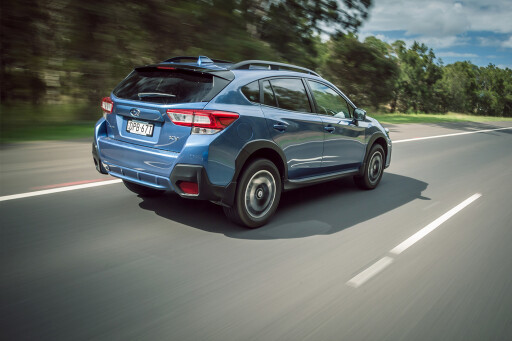
In a straight line, hardly. Not when the modestly powered Subaru shares company with Hyundai’s unexpectedly rapid Kona Elite 1.6T AWD. You’ll pay more for the privilege of the $32,000 Kona Elite’s well-fit performance, but the 130kW 1.6-litre turbo-petrol Hyundai stands head and shoulders above every other small-SUV for thrust, Suzuki’s Vitara Turbo included.
Our test Kona Elite smashed Hyundai’s 7.9sec 0-100 claim into yesterday, recording 7.28sec to triple digits and a scorching 15.41sec for the standing 400m. That’s borderline hot-hatch territory. And it doesn’t quit either. By 160km/h, the Kona is almost eight seconds ahead of the CX-3 and XV, with the leisurely C-HR nowhere to be seen. And in the crucial 80-120km/h overtaking bracket, the Kona is done and dusted in just 4.7sec, barely half the time of the sweet-spinning C-HR (8.3sec).
The Kona sounds determined, too, though it gets thrashy and intrusive at higher revs, and clearly lacks the refinement polish of an i30. And the turbo Kona’s seven-speed dual-clutch transmission – Hyundai’s own – isn’t without fault. It’s slow to engage a gear in low-speed or parking situations, making progress frustratingly (and inconsistently) jerky before suddenly overcompensating with too much urge.
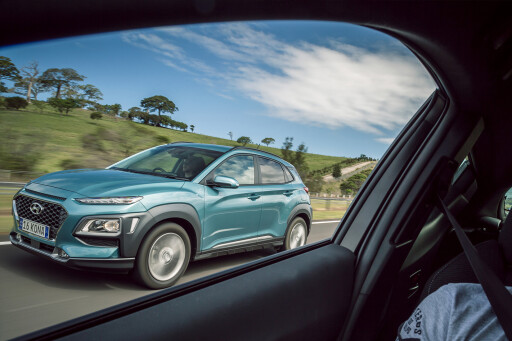
It frequently flares revs, and will even ride its clutches or occasionally serve up neutral, making smooth progress much more of an effort than it should be. But if you want to fire out of the blocks at traffic lights, the Kona’s response is brilliant. The Mazda serves up acoustic keenness with fewer engine-bay vibes than before thanks to last year’s attempt at calming its NVH issues.
The CX-3’s 109kW 2.0-litre donk now winds out to 6700rpm (or beyond) with smooth linearity rather than an intrusive blare, but this mid-life update has been no panacea, leaving it only incrementally improved in overall refinement. That said, we’d rather Mazda’s drivetrain than Subaru’s. Despite offering near identical performance, the XV’s flat four and CVT combo isn’t as satisfying to sit behind.
A vociferous flaring of revs in day-to-day pottering, as well as up in the hills, gets the goat of anyone who’s sensitive to that sort of rukus, yet when you nail it, the XV gives the impression it’s rather weak-kneed. It isn’t, as our four-up test proved – the Subaru cresting a hill from a standing start at an indicated 112km/h, same as the Mazda and better than the Toyota (103km/h), if not the brisk Hyundai (128km/h) – yet there’s also an issue of seeming CVT belt slippage when driving the XV around on a light throttle.
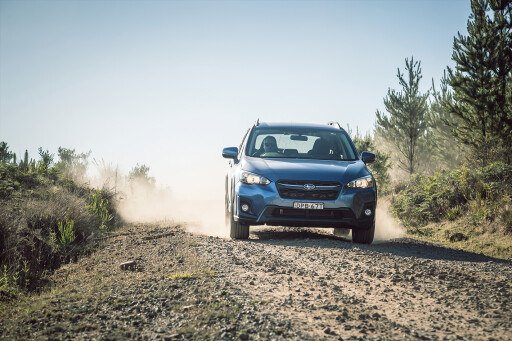
There’s a subtle fore-aft pulsing – something we’ve observed on other current CVT Imprezas – that, while no deal-breaker, is noticeable once you’ve identified it. Relatively knackerless as it may seem on paper (or in reality if you believe the hype of the ‘TURBO’ badge on its front guards), the C-HR is a likeable thing. Get your head around the nonsense of hiding its Drive Mode selection in the instrument-pack screen, accessed via wheel buttons, and there’s much to like.
Crisp CVT response (especially in Sport mode), a neat alloy-topped console shifter with effective manual-mode calibration and excellent engine refinement add to the Toyota’s Teflon-smooth slickness elsewhere. Best economy of the group too, despite being driven flat out much of the time, but the C-HR’s drivetrain really belongs in a Yaris. In this application, the 85kW 1.2-litre turbo-petrol almost feels naturally aspirated, so subtle is its boosted torque and so softly-softly its sense of urgency.
More boost please Toyota! If you’re fortunate enough to be seated in its front row, the charming C-HR has the ability and to make you feel special. Generously cushy front seats, a great view forward, a neat leather-rimmed steering wheel, and an intriguingly styled dash with ‘pillow top’ upper section combine with a bunch of unusual design details (like ‘animal-footprint’ indents in the headlining and diamond-ribbed door inserts) to amp up the C-HR’s cool factor.
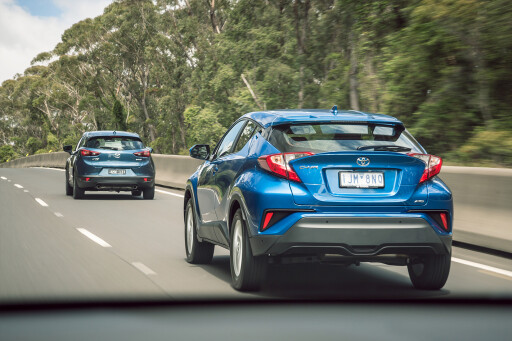
It’s good fun to fling about, too. Toyota’s new-gen global platform is a corker, blending the agility- and balance-enhancing benefits of an independent rear end with terrific refinement and easily the supplest ride of this quartet. The C-HR nonchalantly wafts over bumps that seriously affect the Kona, with a level of body control that eludes the jacked-up XV, and an aura of quietness that elevates this small SUV to a new level.
While the Toyota’s steering may not be filled with feel, it’s accurate and corruption-free, with a pleasantly subtle firmness in Sport mode, though the base C-HR’s 215/60R17 Bridgestone Dueler H/P Sport tyres do more for its road refinement than its cornering grip, despite what the name says. The CX-3 isn’t capable of matching the C-HR’s polish, but it knows how to nail consistency.
The sTouring’s pretty 18-inch alloys (wearing 215/50R18 Toyos) may prove a step too far for its ride quality, depending on the road surface, but they imbue the pert Mazda with the point-ability you’d expect from a car so closely related to the 2. It turns in keenly via a terrific three-spoke steering wheel, it balances neatly on its outside rear tyre in corners and puts its De Dion rear suspension to great use, adding a layer of involvement over the torsion-beam-equipped front-driver by providing noticeable assistance and adjustability from behind.
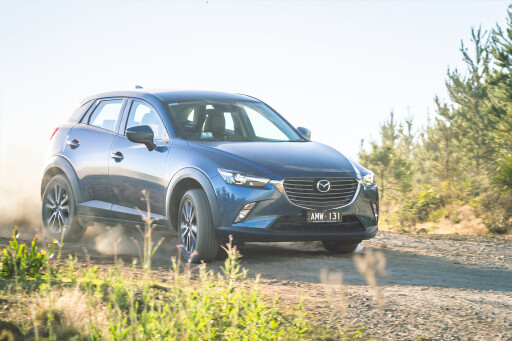
Especially on dirt. The Mazda’s consistency continues inside, blending the quirkiest, yet most cohesive dash layout and switchgear with excellent seat comfort, the sportiest driving position, superb instrumentation (a great big tacho with upper and lower decks of digital speedo) and a classy, all-of-a-piece feel whose working title could’ve been ‘egalitarian chic’. Indeed, despite the CX-3’s obviously working-class roots (much of its dashboard is unashamedly hard black plastic), extremely clever deployment of vinyl trim with exposed red stitching, carbonfibre-effect inserts and piano black lifts the CX-3 sTouring enormously.
The XV also comes laden with exposed interior stitching, this time of the orange (yay!) variety, and it provides welcome relief. Not that there’s much wrong with the new-gen Impreza interior but at least the XV version attempts to garnish it with some North Face cool. There’s much to like inside the Subaru’s cabin, including the best audio quality of this bunch (but the worst radio reception), an unbreakable feel to its controls, and more visual pizazz and texture than most Subarus before it.
Wide-opening doors combine with the XV’s higher hip point and greater ground clearance to make it an easy car to jump in and out of, though the coarse adjustment of the 2.0i-L’s lever-adjust front seats leaves many drivers wanting for true comfort. And probably some extra dynamism. That tall suspension makes the XV noticeably less agile than its Impreza starting point on twisty roads, spoiled by a lack of finessed body control, a lack of grip from its 225/60R17 Yokohama BluEarth tyres, and an understeer bias in most cornering situations. Even on dirt, ESC switched off, it’s difficult to get the XV to play (though that says a lot about the planted stability of its chassis), while on bitumen it’s crying out for some dynamic sparkle. It also fails to take advantage of the greater suppleness its taller suspension should bring.

Instead, in a four-up situation, you’re left with a car that’ll nudge its bump stops on lumpy back roads while offering no encouragement to find any dynamic sweet spot. In 2.0i-L guise, the XV doesn’t appear to have one. The Kona’s inconsistency is even more disappointing. Firstly, its interior. If you’re moving up from a Getz then maybe you won’t notice the hollow hardness of the Kona’s dash and door plastics, or the immaturity of its multimedia switchgear.
Unlike the slightly dearer turbo-petrol i30 SR Premium or turbo-diesel i30 Premium (both $33,950), the Kona’s lack of tactile surfaces is quite jarring, not to mention its lack of digital radio or factory sat-nav – both standard on every i30 model. On the move, the Kona’s driving position delivers a more elevated view, though you tend to sit on top of its short front seat cushions. And there’s some rough-and-ready fun to be had here, at the expense of comfort and refinement. Riding on a 50mm-shorter wheelbase than the i30, but sharing the up-spec SR’s multi-link independent rear end, if you set the Kona 1.6T up for a corner, it’ll turn in keenly and charge through with warm-hatch verve and enthusiasm, thanks to respectable balance and all that power.
But there are many holes in its repertoire. Its pointy steering gels nicely when you’re caning the Kona on well-surfaced roads, but there’s rack rattle over corrugations and surprising heft (for an electric-steer system) to its weighting when parking. And that’s in Comfort. Go a step too far by selecting Sport and the weighting is so heavy it’s almost resistant, while Kona’s ride borders on reactive. Driven at the same 100km/h-plus speeds as its rivals over our four-up test road, the Kona’s rear end frequently impacted with the bump stops, rebounding the body upwards with even less damping finesse and control than the XV, accompanied by the most intrusive coarse-surface tyre noise. Yet even with just the driver on board, the Kona’s urban ride can be joltingly abrasive and uncomfortable.
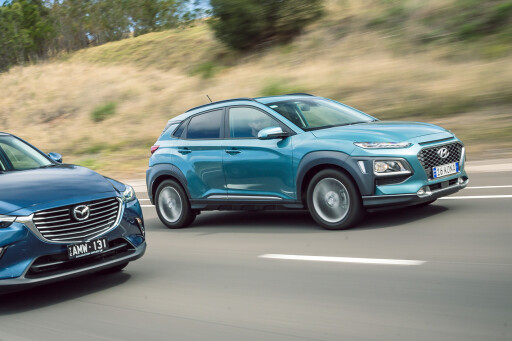
Mercifully, Kona’s core packaging is impressive. Its nicely supportive rear seat offers an elevated view, backed by generous toe room under those high-set front chairs, and its 361-litre boot gets a (slightly flimsy) luggage net, which is unusual in this class. It’s as if someone at Hyundai decided the Mazda CX-3 should be Kona’s package benchmark, and expanded the blueprint by about 10 percent.
Indeed, despite having the shortest wheelbase here, and perhaps an unfounded reputation as being too small, the CX-3 definitely makes the most of what it has. Its front seat backrests are quite thin, but they’re well-shaped and envelop front passengers, without intruding on the limited rear legroom. Yet because the CX-3’s excellent rear bench is mounted quite high, passengers’ legs drop straight down, meaning it doesn’t need length to achieve comfort – ala original Mazda 121 – and has enough forward vision to overcome its rising beltline.
The CX-3’s rear section also delivers “more than enough headroom,” according to 191cm Peter Robinson, and accepts 1.25-litre water bottles (or larger at a squeeze) in its rear doors, where the Kona will only just cop a 600ml Coke. And if you need more space in the Mazda’s boot, you can remove its floor panel to create a deeper cargo bay, though it remains fairly small. As you might suspect from its styling, the C-HR’s interior is a tale of two halves.
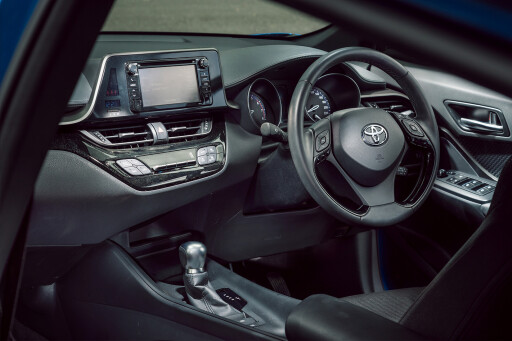
Much of the Toyota’s otherwise-polished sophistication frays at the seams once you move into its rear seat … and discover a bench without any under-thigh support and a level of vision that’s laughably compromised. The most hated passenger would be sentenced to the back left, staring at intrusively oversized front buckets – exacerbated by a lack of height adjustment for the front passenger, leaving the seat mounted too high – and the claustrophobic effect of anthracite headlining.
While front-seaters are hardly blessed with abundant storage and clever use of oddment space, those in the rear truly get nothing. A centre armrest, map pockets, grab handles, air vents, a USB port …. they’re all still on a Santa Claus wish list. For 2016. Like the Impreza it shares fluids with, the XV’s rear quarters are vast. The easiest entry, the best rear legroom and the only privacy glass of this group set the Subaru apart, despite its back seat not quite matching the Mazda for quality of support.
It also has ample vision, undermined slightly by a greater volume of tyre noise than what those up front experience. But then there’s the XV’s ride. It’s not bad; it’s just that alongside the plushness of the C-HR or the well-controlled firmness of the CX-3, the XV sits in a no-man’s land of acceptable mediocrity. And that’s how the XV finishes up in this test. There’s a disconnect with the Subaru – blending a funky interior with an exterior so conservative it can be difficult to differentiate from its predecessor – that somehow misses the small-SUV zeitgeist.
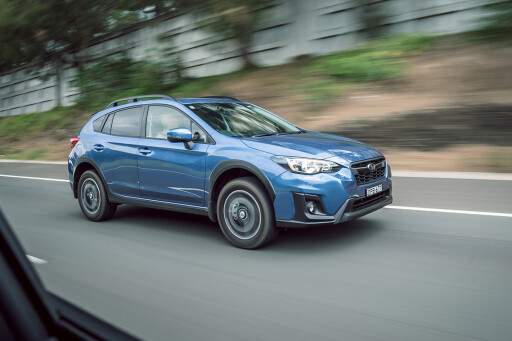
That said, perhaps the XV’s lack of visual excitement underpins the market it’s targeting. More than 10,000 Aussies chose the XV’s bulletproof feel and daggy-but-dependable reputation last year, though unless you live on a farm or tackle bush trails, a (cheaper) Impreza 2.0i-S hatch is a far superior choice. So who would we recommend a Kona Elite to? Not sure exactly. Hyundai already builds an infinitely better car in the i30, with superior everything apart from a lack of AWD and a lower seating position, but if an SUV is a must-have, the Kona has its strong suits: individuality, space, performance, smooth-road handling, strong air-con...
But its flaws are too obvious to ignore, even though you can drive around a few of them (like big potholes). Our test car also had a few panel-fit issues around the tailgate and front-left mudguard – unusual for a modern Hyundai.
So, yet again, we’re left with two very different small-SUV designs eyeballing each other for the win. The updated CX-3 is by far the more consistent of the two. It manages to look and feel classy while delivering a sizeable dose of driver appeal, and it squeezes impressive packaging efficiency from the smallest footprint here. The Mazda might be a more conservative car than the Toyota (yes, really) but it’s a better all-rounder for it.
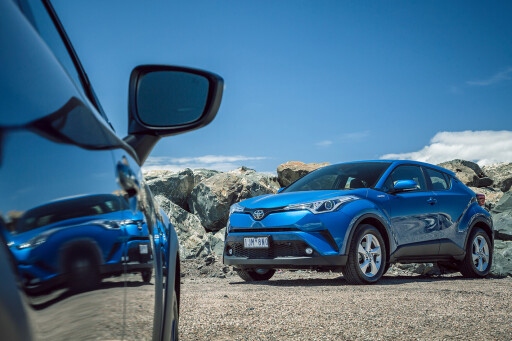
Yet there’s something about the C-HR that makes it a hard car to dismiss. Its refinement slickness, drivetrain sweetness, ride suppleness and handling depth elevate it to a higher level for anyone after an occasional four seater that truly pampers two occupants. If you can look past its dearth of in-cabin storage, or the criminal lack of vision from its back-left seating position, then the C-HR has so much to give.
We’d probably want to chip it for more boost pressure and fit proper road tyres, but there’s a fluency and purity to the way it goes about its business that points the evolution of the small SUV in a new direction.

COMMENTS